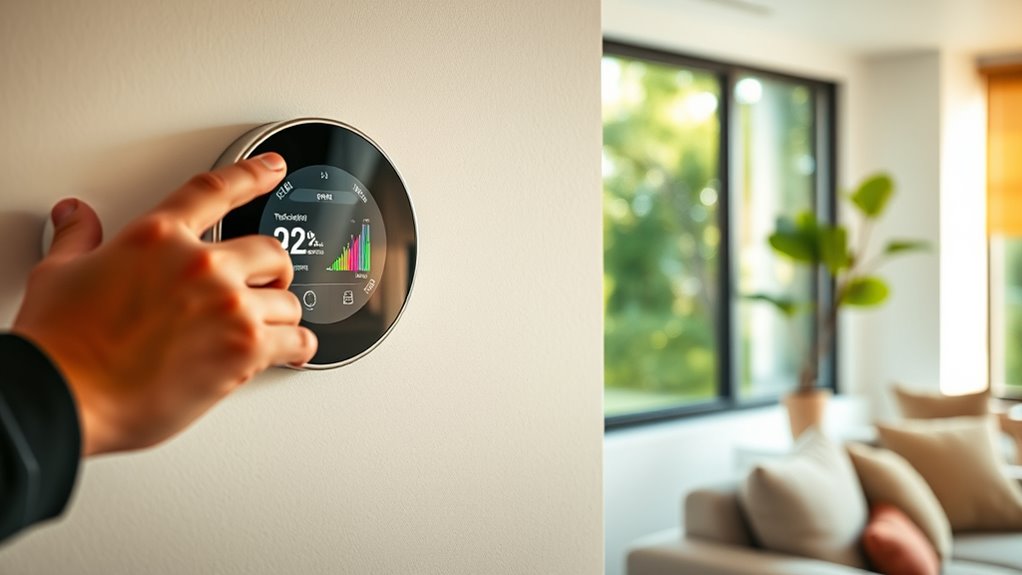To measure CO2 reductions from your smart thermostat, track your energy usage over time and compare it to previous bills or data before installation. Use the device’s reports to see how your engagement and schedule adjustments reduce energy consumption, especially during unoccupied periods. Since lower energy use cuts greenhouse gases, monitoring these patterns lets you estimate your emissions savings. Keep exploring—more tips on maximizing your environmental impact await.
Key Takeaways
- Analyze energy consumption data before and after installing the thermostat, considering regional CO2 emission factors.
- Use smart thermostat reports on temperature adjustments and automation patterns to estimate energy savings.
- Calculate CO2 reductions by correlating decreased energy use with local electricity generation emissions.
- Track user engagement in scheduling and eco modes, which amplify greenhouse gas reduction potential.
- Regularly review energy and emission reports to quantify long-term CO2 savings achieved through active participation.

Smart thermostats are transforming how we manage energy use at home, but understanding their true impact requires careful measurement. When you install one, you might notice immediate comfort improvements, but the real benefit lies in the energy savings and the potential reduction in CO2 emissions. To accurately gauge these benefits, you need to look beyond surface-level data and examine how user engagement influences energy consumption patterns. Higher user engagement, such as adjusting settings or using learning features, typically leads to more significant energy savings over time. The more you interact with your smart thermostat, the better it adapts to your routines, optimizing heating and cooling schedules to reduce unnecessary energy use.
Tracking energy savings involves analyzing your energy bills before and after installation, but it’s also essential to appreciate the thermostat’s data on temperature adjustments and system activity. Many smart thermostats offer detailed reports, allowing you to see how much energy is being conserved through intelligent scheduling and automation. These insights help you understand whether your engagement levels are translating into tangible reductions in energy demand. For example, if you’re consistently adjusting your thermostat to save energy when you’re away or asleep, your device can learn from these patterns and fine-tune its operations, leading to greater energy savings and a corresponding decrease in CO2 emissions.
Measuring the impact on CO2 emissions requires understanding the source of your electricity. If your utility relies heavily on fossil fuels, reducing energy consumption directly cuts CO2 output. Smart thermostats contribute to this by minimizing wasted energy, especially during peak hours or when the home is unoccupied. To quantify this, compare your energy usage data with regional emission factors, which estimate how much CO2 is produced per unit of electricity consumed. Over time, consistent user engagement—such as setting temperature schedules, enabling eco modes, or responding to energy reports—amplifies the greenhouse gas reduction potential of your smart thermostat. Additionally, understanding whole‑house water filtration systems and their impact on energy use can help you optimize your entire home’s energy efficiency.
In the end, the key to maximizing the CO2 reduction benefits of your smart thermostat lies in active participation. By staying engaged, understanding your device’s data, and making informed adjustments, you not only save money but also contribute to a cleaner environment. Measuring these reductions might seem complex initially, but with regular review and proactive use, you’ll see how your everyday actions translate into meaningful environmental benefits. The more you leverage your smart thermostat’s capabilities, the more significant the impact on energy savings and CO2 emissions, making your home smarter and greener.
Frequently Asked Questions
How Accurate Are Smart Thermostat CO2 Reduction Measurements?
Smart thermostat CO2 reduction measurements are generally quite accurate, but their precision depends on proper sensor calibration and data accuracy. When sensors are well-calibrated, they reliably track changes in your home’s energy use and CO2 emissions. Keep in mind that environmental factors or sensor drift can affect data accuracy over time. Regular calibration and maintenance ensure your smart thermostat provides the most precise CO2 reduction data possible.
Can Smart Thermostats Reduce CO2 Emissions in Commercial Buildings?
Imagine a skilled captain steering a ship through turbulent waters—smart thermostats can do the same for your commercial building’s emissions. By optimizing occupant behavior and embracing proper maintenance practices, these devices cut CO2 emissions effectively. They adapt to changing conditions, ensuring energy isn’t wasted. You take control, making smarter choices that lead to greener operations and a healthier environment, just like a captain guiding their ship safely home.
Do Different Brands of Smart Thermostats Vary in CO2 Savings?
Yes, different brands of smart thermostats vary in CO2 savings due to brand comparison and feature variability. You’ll find that some brands offer advanced learning algorithms, energy-saving modes, and better integration with building systems, which enhance CO2 reduction. By comparing brands, you can choose a thermostat that maximizes your building’s energy efficiency. Ultimately, selecting the right brand with the right features makes a significant difference in your CO2 savings.
How Do Climate Zones Impact CO2 Reduction Effectiveness?
Climate zones considerably impact your CO2 reduction potential with smart thermostats because each zone has different cooling requirements. In warmer zones, you’ll see greater savings by optimizing cooling, while in cooler zones, heating adjustments matter more. Your thermostat’s ability to adapt to these climate-specific needs boosts energy efficiency, lowering CO2 emissions. By tailoring your settings to your climate zone, you maximize your environmental benefits and reduce your carbon footprint effectively.
What Are the Long-Term Environmental Benefits of Using Smart Thermostats?
Using smart thermostats offers long-term environmental benefits by promoting energy conservation, reducing greenhouse gas emissions, and combating climate change. When you optimize your heating and cooling, you save energy, lower your carbon footprint, and help preserve natural resources. Over time, these small actions add up, making a significant difference in creating a more sustainable future. Your consistent use of smart thermostats supports global efforts to address climate change and protect the planet.
Conclusion
Think of your smart thermostat as a silent gardener tending to your home’s energy garden. With each adjustment, it trims waste and nurtures efficiency, transforming your space into a greener sanctuary. The CO2 reductions are like blossoming flowers, symbolizing a healthier planet blooming from your small actions. By embracing smart technology, you become the gardener of a sustainable future, where every degree saved helps nurture the Earth’s delicate balance.









